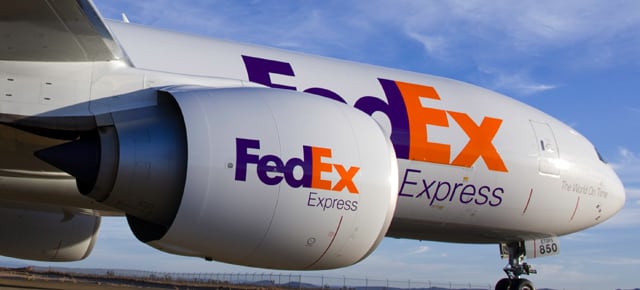[Avionics Today 09-01-2015] Cargo airline FedEx Express, which operates the world’s fourth largest fleet, has its eyes on major fleet modernization initiatives to introduce newer, more operationally efficient aircraft into the fleet. Earlier this summer, the Memphis, Tenn.-based airline announced the purchase of 50 Boeing 767-300F aircraft scheduled for delivery between 2018 and 2023 to the tune of nearly $10 billion at list prices — the largest order for the 767 to date. The purchase announcement follows on the heels on the company’s accelerated retirement of 15 aircraft and 21 related engines, including: seven MD11s, three Airbus A300s, four A310-300s and one MD10-10. The cargo carrier also adjusted the retirement schedule of an additional 23 aircraft and 57 engines.
 |
| FedEx Express plane. Photo: FedEx |
These early retirements, according to FedEx Corp.’s fourth quarter earning’s report, resulted in $276 million impairment and related charges, which, alongside lower fuel surcharges and unfavorable currency exchange rates, may have contributed to the company’s 4 percent revenue drop for the quarter in the FedEx Express segment when compared to 2014. Despite the current impact, Michael Bielskis, communications advisor at FedEx Express, noted that the early retirement has had no effect on flight routes for the global company and, in the long run.
“The retired aircraft were replaced with a combination of 757 and 767 aircraft or were parked based on efficiency initiatives related to FedEx’s Profit Improvement Program,” said Bielskis, referencing the company’s initiative to up improve operating profits by $1.6 billion at FedEx Express by the end of fiscal year 2016.
“[The new aircraft] will modernize the FedEx Express fleet through improved reliability and fuel-efficiency,” Bielskis said. “Mechanical reliability and fuel efficiency are keys to our decision-making.”
The company is also looking to up operational efficiency with several avionics upgrades across the fleet for the incoming aircraft.
“FedEx is installing [Innovative Support and Solutions] IS&S displays on our 757-200SF fleet and the Rockwell Collins Large Display System (LDS) on our 767-3S2F deliveries,” said Bielskis. The new displays promise to offer greater control, less weight and lower fuel burn, according to the companies, and lower operating costs.
The current fleet will see some changes as well, including equipping for Required Navigational Performance (RNP), which promises to enable more efficient approaches to runways, including curved paths.
“With respect to existing fleets, FedEx has made recent investments into 757 RNP software, 757 Future Air Navigation System (FANS) software, and MD11 Flight Management System (FMS) enhancements to accommodate RNP. Finally, FedEx is installing Head Up Displays/Enhanced Flight Vision Systems (HUD/EFVS) on our 777, 767 and 757, MD11 and MD10 fleets,” Bielskis explained.
Going forward, the company is currently evaluating a Flight Management System (FMS) upgrade to its A300-600 and A310-300 fleets to accommodate an increasing number of way-points and to fly RNP routes, including Radius-to-Fix Leg (RF Leg).
Connectivity is also on the menu, with the company pursuing an Aircraft Interface Device (AID) for its fleet that will eventually provide satellite connectivity and data such as updated weather forecasts to the crew during flight.
Last, the cargo airline is also equipping to comply with upcoming NextGen mandates by upgrading all FedEx Express aircraft transponders to DO-260B requirements in order to comply with the FAA’s FAR 91.225. The mandate lays out the Automatic Dependent Surveillance-Broadcast (ADS-B) equipment requirements necessary to operate in certain classes of airspace, effective Jan. 1 2020.